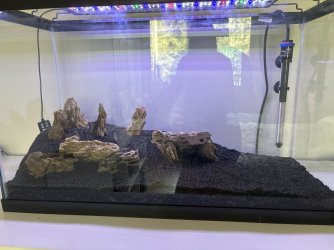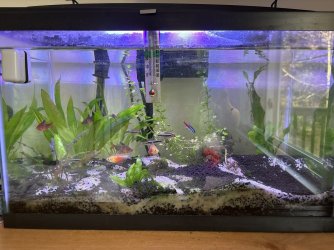Here is he best advice i can give you here. Ignore everything you have read in this thread except the following and you will be fine, They key is to follow the directions on the site where I am about to send you. Bo not deviate from the directions, do not listen to anybody who suggests you should and you will have your tank up and ready to recive a full fish load in short order.
I have cycle a bout 150 tanks or more over the years. I can set up a tank and stock it 100% in a single day and lose no fish. But I have been at this for a few decades. The keys to cycling are pretty simple.
1. How much bacteria one can have at the start is the first major derterminent of how long a full cycle will take.
2. The bacteria reproduce when there is more ammonia/nitrite than they need to thrive. Conversly they die back when there ius less than they need.
3. There are a few more things they need- carbonates/bicarbonates/CO2. The need inorganic carbon. they need iron and some other trace elements, many of these are in our tap.
4. Plants use ammonium (NH4) and the bacteria prefer ammonia (NH3). The plants can use ammonium faster than the bacteria can use ammonia. Elevated ammonia (NH3) can actually harm plants. And just like with fish different plants can be more or less susceptible .
5. It is possible to use only plants to make a tank ammonia safe. This takes time and requires one stock gradually. Tanks plants actually host nirtifying bacteria.
6. When using plants one must understand that different [plants will use ammonium faster or slower and that the toal mass of plants in a tank is also relevant in terms of how much bacteria is needed in addition to the plants.
Since you want to move over all the fish, you need to know the new tanks is safe for them all. Since we cannot see or measure tha actual bacterial numbers in a tank, the only way we can tell if a tank is fish safe is to test for ammonia and nitrite.
So if you are in a rush to get a tank cycled you have a few options depending on you level of knowledge and experience. You can get the tank ctcled in about 10-14 days with no plants and using Dr. Tim's One and Only. If you want to try the planted clow cycle, then you need to pant and let the plants settle in for about 10- 14 days. The add fish.
If you want to do a light planting and use bacteria, you need to reduce the amount ammonia being added to protect the plants. If you want to got the plant only route, then you still need to do an ammonia dose to know how much ammonia the plants can handle. if you want to go that route, I can explain how you can dose and test safely. It is important to use the right ammonia or you can use ammonium chloride.
Dr. Tim sells ammonium and so does Fritz- Firtx Fishless Fuel
https://fritzaquatics.com/products/fishless-fuel
Please be aware that both of the above products use a different scale for testing than most of us as hobbyists do. Scinece uses the Nitrogen scale which only measures the nitrogen. Hobby kits test total ions which means they include the Hs in ammonia (NH3) and the Os in Nitrite (N02) and Nitrate (NO3). So, you need to compensate for this in your testing and dosing.
Fortunately, both products use 4 drops/gallon to produce what they call 2 ppm of ammonia using the Nitrogen scale.
On a hobby kit this should read about 1.29 times as much. So our test kits will measure that 2 ppm as 1.56 ppm. For nitrite the multiplication factor becomes about 3.28. it gets bigger again for nitrate but do not worry about that here.
Finally. both unplanted and planted tanks need their water changed weekly. We do this for two reasons. The first is it removes some of the bad things we do not want yo accumulate in the water. The second reason is that things we need and want in the water get used up by the fish. Plants and any other critters we keep. So the regular water changes serve 2 purposes. There is a bit of wiggle room. Heavily stocked tanks may need more frequent changes while lightly sticked tanks can go a bit longer between changes. I just change water in all 20 of my tanks weekly. It makes it easy to keep track.
Just bear in mind that you will never hear about fish dying because their water was too clean. Clean doesn't mean pure, it means not having things in it that can harm the fish etc.




